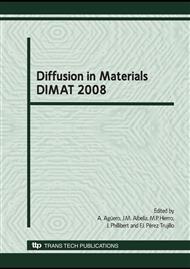p.641
p.649
p.657
p.665
p.673
p.679
p.689
p.697
p.705
Shrinkage of Hollow Nanoparticles of Oxides of Cu and Ni at High Temperatures
Abstract:
The structural stability of hollow Cu2O and NiO nanoparticles, which were obtained via oxidation of Cu and Ni nanoparticles in air, was studied by transmission electron microscopy (TEM). Hollow Cu2O and NiO were observed to have shrunk at 473 and 623 K in annealing under 5.0×10-5 Pa, respectively, where the reduction reactions from oxides to metals started. As a result of shrinking associated with reduction, hollow oxides turned into solid metal nanoparticles after annealing at higher temperatures for a long time. In addition, hollow oxides shrunk and collapsed through high-temperature oxidation. It was found that shrinking of hollow oxides during oxidation occurs at temperature where the diffusion coefficients of slower diffusing species reach around 10-22 m2s-1. It seems that the hollow oxide nanoparticles tend to shrink and collapse at high temperatures because the hollow structures are energetically unstable.
Info:
Periodical:
Pages:
673-678
Citation:
Online since:
April 2009
Authors:
Keywords:
Price:
Сopyright:
© 2009 Trans Tech Publications Ltd. All Rights Reserved
Share:
Citation:


